Hotel Seman in Kashgar - former Russian consulate
In Kashgar, we stayed at a very pleasant hotel called Seman. It was partially housed in the building that was built for hte Russian consulate in the nineteenth century. The interior was very nice. We got to stay there an extra night (but in new rooms) because of the sandstorm that prevented our departure.
The consulate has some interesting history. The great Finnish statesman Carl Gustaf Mannerheim, who would go on to become both the Commander in Chief of the Finnish armed forces in World War II, Marshal and President of Finland, stayed here in 1906 at the beginning of his trip through China, where he spied on military instalments. As a Finlander, Mannerheim was a subject of the czar and he was an officer in the Russian cavalry. He pretended to be an ethnographic collector and joined the expedition of the great French sinologist Paul Pelliot. He had a falling-out with Pelliot early on, so he did most of his trip on his own, spying out Chinese military installations in preparation for a possible Russian invasion of western China.



The consulate has some interesting history. The great Finnish statesman Carl Gustaf Mannerheim, who would go on to become both the Commander in Chief of the Finnish armed forces in World War II, Marshal and President of Finland, stayed here in 1906 at the beginning of his trip through China, where he spied on military instalments. As a Finlander, Mannerheim was a subject of the czar and he was an officer in the Russian cavalry. He pretended to be an ethnographic collector and joined the expedition of the great French sinologist Paul Pelliot. He had a falling-out with Pelliot early on, so he did most of his trip on his own, spying out Chinese military installations in preparation for a possible Russian invasion of western China.



Turpan karez water system
Turpan is an oasis in the Taklamakan desert (the second largest desert in the world after the Sahara). It is a large oasis which is famous for growing excellent grapes and melons. It is thanks to a clever irrigation system that the oasis has become so large.
The system consists of many underground canals that catch the ground water and leads it to the oasis. The canals connect dug wells. It all works thanks to the geography of the area. Look at the picture below, which shows a model of how it works. The Tianshan (Heavenly mountains) away in the picture are tall and snowcovered year-round. A lot of water comes from them. Some of this water becomes ground water, which collect north of the next, lower mountain range, the Flaming mountains. The area between the two mountain ranges becomes an underground water reservoir. When the ground water makes it over the Flaming mountain range it is collected in wells and then led to Turpan in underground canals. The canals have to be underground, because Turpan is so hot that the water would evaporate if it were on the surface. (When we arrived in the late afternoon, the temperature was 38, but it had been hotter earlier in the day, and this was in early September).
The system is a thousand years old or more!
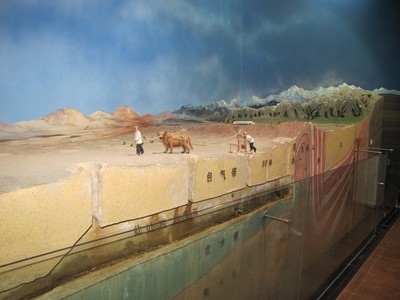
The representation of Turpan in the model. On the right side, one can see how an underground canal comes out on the surface to provide water for the oasis. Turpan is a deep valley, the second lowest point in the world after the shores of the Dead Sea, and well below sea level.

In the museum, one could also go down underground to see a real karez, and here it is.


An amazing testimony to human ingenuity.
The system consists of many underground canals that catch the ground water and leads it to the oasis. The canals connect dug wells. It all works thanks to the geography of the area. Look at the picture below, which shows a model of how it works. The Tianshan (Heavenly mountains) away in the picture are tall and snowcovered year-round. A lot of water comes from them. Some of this water becomes ground water, which collect north of the next, lower mountain range, the Flaming mountains. The area between the two mountain ranges becomes an underground water reservoir. When the ground water makes it over the Flaming mountain range it is collected in wells and then led to Turpan in underground canals. The canals have to be underground, because Turpan is so hot that the water would evaporate if it were on the surface. (When we arrived in the late afternoon, the temperature was 38, but it had been hotter earlier in the day, and this was in early September).
The system is a thousand years old or more!

The representation of Turpan in the model. On the right side, one can see how an underground canal comes out on the surface to provide water for the oasis. Turpan is a deep valley, the second lowest point in the world after the shores of the Dead Sea, and well below sea level.

In the museum, one could also go down underground to see a real karez, and here it is.


An amazing testimony to human ingenuity.
Numismatic museum, Beijing
Last Friday we also visited the Numismatic museum in Beijing, housed in a beautiful old bank building. There was in interesting exhibition of Chinese currency through the ages, including some really old paper money.
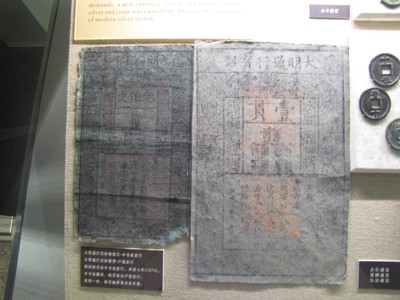
A lot of space was devoted to the efforts of the various Communist groups to issue money during the Chinese civil war. I take it that the Communists were so divided geographically that each group had to issue its own money. A few of the Chinese "soviets" issued bills with the countance of Lenin.
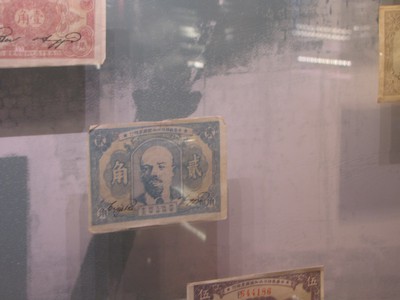
No explication in any language I can read here, but I take it this is a lithographic stone with which the bills were printed. I have never seen such a stone before.
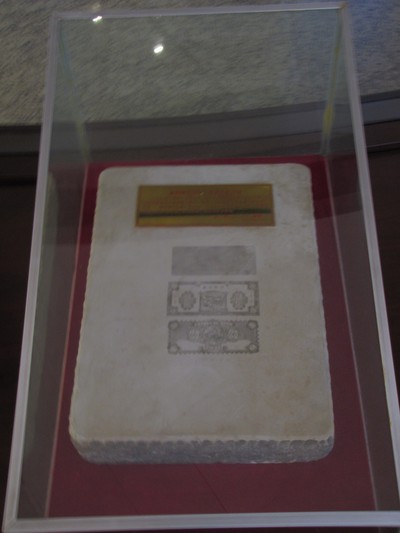
The exhibition was interesting (I did, for example, get to see those "strings of cash" that they constantly talk about in Dream of the Red Mansions). It was funny to compare this museum to the numismatic museum in Stockholm (Kungliga Myntkabinettet), which I visted in July. Both museums very strongly emphasized the currency of their own country, but the Stockholm one also had some international exhibits. Among those I remember seeing both bills issued in the Western concessons in China and even emergency money issued in the legation quarter in Beijing during their siege in the Boxer rebellion. This is part of China's monetary history, but I suppose it is not shown in China, for ideological reasons. On the other hand, I do not remember in Stockholm seeing any money issued by the Chinese communists before 1949.
Sorry for the quality of the images. It is hard to photograph through glas monters.

A lot of space was devoted to the efforts of the various Communist groups to issue money during the Chinese civil war. I take it that the Communists were so divided geographically that each group had to issue its own money. A few of the Chinese "soviets" issued bills with the countance of Lenin.

No explication in any language I can read here, but I take it this is a lithographic stone with which the bills were printed. I have never seen such a stone before.

The exhibition was interesting (I did, for example, get to see those "strings of cash" that they constantly talk about in Dream of the Red Mansions). It was funny to compare this museum to the numismatic museum in Stockholm (Kungliga Myntkabinettet), which I visted in July. Both museums very strongly emphasized the currency of their own country, but the Stockholm one also had some international exhibits. Among those I remember seeing both bills issued in the Western concessons in China and even emergency money issued in the legation quarter in Beijing during their siege in the Boxer rebellion. This is part of China's monetary history, but I suppose it is not shown in China, for ideological reasons. On the other hand, I do not remember in Stockholm seeing any money issued by the Chinese communists before 1949.
Sorry for the quality of the images. It is hard to photograph through glas monters.
The Emin Mosque in Turpan
The famous Emin Mosque in Turpan was built in the second half of the eighteenth century (1777-1778, according to Wikipedia). The minaret is 44 meters high and is the tallest minaret in China. All of it is built of sun-dried mud bricks. Such bricks do not withstand water, so if there would be a real downpour with rain, the mosque would be destroyed. In other words, Turpan has not had a real downpour since at least the late eighteenth century!

The mosque is now a government-run museum, even if it is used for Friday prayers, so we could go in without observing any dress code (unlike in the Great mosque of Kashgar). The inside was impressive.

It has not rained properly in Turpan for more than two centuries, but there are often very strong winds blowing through the Taklamakan desert. In a recent such wind a wall in the mosque was blown down. Astonishing.


The mosque is now a government-run museum, even if it is used for Friday prayers, so we could go in without observing any dress code (unlike in the Great mosque of Kashgar). The inside was impressive.

It has not rained properly in Turpan for more than two centuries, but there are often very strong winds blowing through the Taklamakan desert. In a recent such wind a wall in the mosque was blown down. Astonishing.

Grape valley in Turpan
Turpan is an oasis in the Taklamakan desert, famous for its melons and grapes. Grape valley is one of the places where grapes grow and that is also a tourist destination. A very pleasant place to stroll in the shade of the grapevine.

The gang.

Lucy and I had freshly squeezed grape juice. Enormously delicious!
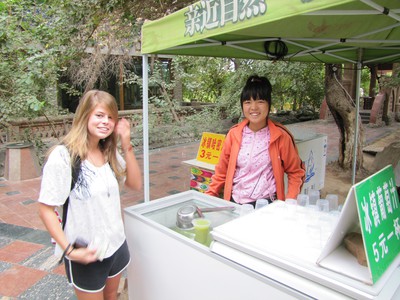


The gang.

Lucy and I had freshly squeezed grape juice. Enormously delicious!


Jiaohe ruins
We visited the ruins of the city Jiaohe, not far outside Turpan. The city was located on a small island where a river splits in two. The island is entirely occupied by a tall cliff with steep sides, providing very good natural defenses. On the top of the cliff, people carved out houses in the (sandstone?) rock. The city was the capital of the "Anterior Jushi Kingdom" from 108 BC to 450 AD. I wish I knew more about who this people were - they do not even have a Wikipedia entry in English. Turpan was the place where (at some point around 1900) remnants of the dead Indoeuropean language Tocharian were found, and it would be interesting to know whether the speakers of Tocharian lived here.
The site was at any rate very interesting. The sandstone is quite eroded, since the city has been abandoned since it was conquered by the Mongols in the thirteenth century.

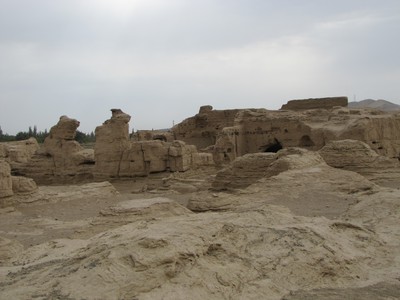

We were allowed to enter down into one of the buildings, which was called "the government office". Miles took the opportunity to sit on the edge and wiggle his feet, to the great amusement of the Chinese visitors to the site.
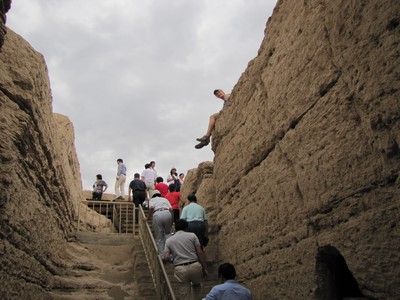
Here is our excellent guide Alem, who took us around both Ürümqi and Turpan.

And finally my daily photo for September 2.
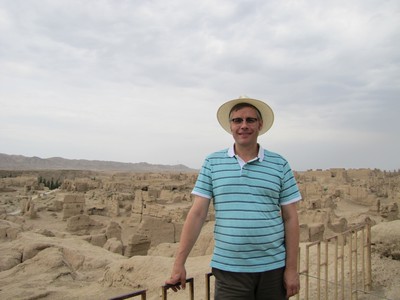
The site was at any rate very interesting. The sandstone is quite eroded, since the city has been abandoned since it was conquered by the Mongols in the thirteenth century.



We were allowed to enter down into one of the buildings, which was called "the government office". Miles took the opportunity to sit on the edge and wiggle his feet, to the great amusement of the Chinese visitors to the site.

Here is our excellent guide Alem, who took us around both Ürümqi and Turpan.

And finally my daily photo for September 2.

Fresh nan in Ürümqi
On our way to dinner our only night in Ürümqi, we found this bakery, where they baked what in Uighur is called "nan" (different from Indian nan). The round ring in the middle of the picture is the oven, shaped like a standing-up barrel. The dough is fastened on the inside of the barrel and is baked there. Several of us bought each a piece of bread. I broke the ice. The students claimed that I got my bread cheaper then they got theirs (probably because I smiled when I asked for it, I argued).
It was absolutely delicious, and so hot that it was hard to hold.

It was absolutely delicious, and so hot that it was hard to hold.

My cute kids on Skype today

Beijing's earliest railway station
We actually intended to go to the Beijing railway museum, which is housed in the city's earliest railway station, which you can see below. Very nice railway architecture from around 1900. Alas, the museum was closed for reparations - something that is all too common in China.


Finally Peking Duck
Today I finally got Peking Duck. It was delicious, of course. We had lunch at one of the city's most famous Peking Duck restaurants. Our meal was also the official welcoming banquet of the Program this semester. Thank you, Ningping and Xiaojie!

Waiting for the duck.
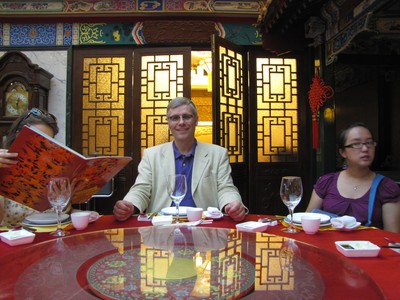

Waiting for the duck.

Urban planning exhibition
Today, September 10, the Yale program organized an excursion to central Beijing. We first looked at the Urban planning exhibition, which is a museum devoted to Beijing. The guided tour and much of the exhibits focused very much on modernity. We got to admire models of various buildings built for the Olympics in 2008, and the tallest buildings, the "Beijing Silicon Valley", and other modernities were especially pointed out to us. Not much about historic preservation. Instead, the guide pointed out that the old small alleys in the hutongs were narrow and crooked. (Indeed, my Baedeker from 1912 warns that they stink and are impossible to get through when it has rained). Of course, the hutongs are being replaced by modern concrete, steel, and glass. According to the Lonely Planet guide to Beijing, 3679 existed in the 1980s, while in 2006 only 430 remained. More will have disappeared since then. Beijing's old buildings are, thus, suffering much of the same fate, and for the same reasons, as the are around St. Clare's church in Stockholm did in the 1960s, altough on a much greater scale. Mao wanted Beijing to become a productive, industrial city, while his successors over the last twenty years are making Beijing into a city of high raises, steel and concrete.
In Stockholm, the government ran out of money before they were able to raze the Old City, which was then something of a slum: unsanitary and not very wholesome. Of course, by now all of it has been carefully renovated through private initiative, and it is among the absolutely most attractive addresses to live in Sweden. It is certainly no longer an unsanitary slum. Perhaps something for Beijinng to learn from?
A great part of the exhibition was a model of the entire city.

But there were signs already at the exhibit that things might be changing in Beijing. For one there was this wonderful model of the Forbidden city.

But perhaps more importantly, there was a newly opened section on historic preservation. Oddly, this was not included in the tour (it looked very new, and there was actually not that much to look at there). At the entrance to this section there was a sequence of busts of the people who drew up the plans for the city in the Yuan, Ming, and Qing periods, and last came Liang Sicheng, who was a professor of architecture at our neighbor, Qinqhua University. He worked on preserving the old architecture of Beijing. The fact that he is given a bust in the Urban planning exhibition suggests that the government has come to share something of his vision, which makes me happy. Unfortunately, they also in Beijing seem to be stuck in the kind of thinking that produces heavy-handed reconstructions (like in Datong) in the style of the much reviled Viollet-le-Duc.

In Stockholm, the government ran out of money before they were able to raze the Old City, which was then something of a slum: unsanitary and not very wholesome. Of course, by now all of it has been carefully renovated through private initiative, and it is among the absolutely most attractive addresses to live in Sweden. It is certainly no longer an unsanitary slum. Perhaps something for Beijinng to learn from?
A great part of the exhibition was a model of the entire city.

But there were signs already at the exhibit that things might be changing in Beijing. For one there was this wonderful model of the Forbidden city.

But perhaps more importantly, there was a newly opened section on historic preservation. Oddly, this was not included in the tour (it looked very new, and there was actually not that much to look at there). At the entrance to this section there was a sequence of busts of the people who drew up the plans for the city in the Yuan, Ming, and Qing periods, and last came Liang Sicheng, who was a professor of architecture at our neighbor, Qinqhua University. He worked on preserving the old architecture of Beijing. The fact that he is given a bust in the Urban planning exhibition suggests that the government has come to share something of his vision, which makes me happy. Unfortunately, they also in Beijing seem to be stuck in the kind of thinking that produces heavy-handed reconstructions (like in Datong) in the style of the much reviled Viollet-le-Duc.

Arriving in Ürümqi
Eight students, two administrators, and I went on this fantastic trip to see Xinjiang, the part of China furthest to the west. It is strictly speaking not a province but an autonomous region. The majority of the population is not Chinese but Uighur, although the government has very much encouraged Han Chinese to move to Xinjiang, so that in the regional capital Ürümqi, half of the population is now Han Chinese. As I understand, the two populations are geographically segregated. Last year there were ethnically motivated riots, about which very little is known since no westerners were allowed into Xinjiang at the time and Chinese media toe the official line.
We had a wonderful time in Xinjiang, where we visited three cities: Ürümqi, Turpan, and Kashgar. The two last are oases in the Taklamakan desert, and Kashgar is in the very west of China.
Here are the students after arrival, waiting for our checked-in luggage.

Russians and people from other former Soviet republics often come to Ürümqi. The airport has flights from these places, and there is a railroad to Kazakhstan, which conveys a lot of trade between China and the former Soviet Union. I believe there must be some tourism as well. At least there are often signs in Russian. I particularly liked this sign at the airport with the same text in four languages in four different writing systems: Uighur, Chinese, English, Russian. A truly cosmopolitan place, as is appropriate for a place on the Silk road.

Ja, så en bild av mig straxt efter ankomst till Ürümqi.

We had a wonderful time in Xinjiang, where we visited three cities: Ürümqi, Turpan, and Kashgar. The two last are oases in the Taklamakan desert, and Kashgar is in the very west of China.
Here are the students after arrival, waiting for our checked-in luggage.

Russians and people from other former Soviet republics often come to Ürümqi. The airport has flights from these places, and there is a railroad to Kazakhstan, which conveys a lot of trade between China and the former Soviet Union. I believe there must be some tourism as well. At least there are often signs in Russian. I particularly liked this sign at the airport with the same text in four languages in four different writing systems: Uighur, Chinese, English, Russian. A truly cosmopolitan place, as is appropriate for a place on the Silk road.

Ja, så en bild av mig straxt efter ankomst till Ürümqi.

My rug from Ürümqi
I bought a small rug at the bazar in Ürümqi. There was a very sweet saleswoman who made a great, but understated show off being shocked at the meagre price I offered for the rug. Of course, I paid far too much for it, but I really like it. It is woven of silk thread. The saleswoman assured me that it was handmade, which is hard to believe, except that I think I actually see some irregularities on its back. Of course, those could have been made on purpose. The main thing is that I like it. It is incredibly soft. I have it next to my bed, and it will work very well in my bedroom in New Haven.


Voting and "Journey to the West"
Today I took my passport and the subway to the Swedish Embassy on the other side of town. I voted in the Swedish parliamentary elections. It was all very fast and relaxed, and I spoke to a nice Swedish woman who took my vote, putting it in an envelope for its onward journey to Stockholm.
Since I anyway was in the embassy and expatriote section of Beijing, I walked over to a shopping centre called Lufthansa, which had been recommended me. They had the usual selection of expensive western stuff, jackets from Hugo Boss and so forth. So I did not buy much, but I found a nice bookstore with foreign books hidden in a corner of the fourth floor. There I bought a set of our volumes of the famous Chinese novel Journey to the West from the sixteenth century. I have had to return the Dream of Red Mansions to the Program library since the semester now has started and students need to have access to the books.
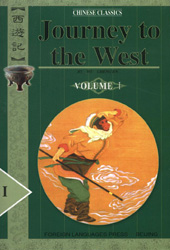
The translation was published by the Foreign Languages Press in Beijing and the four volumes cost only 95 Yuan. The picture is from their website.
Alas, my cold seems to have restarted today. I hope to get better for tomorrow's excursion to two Beijing museums.
Since I anyway was in the embassy and expatriote section of Beijing, I walked over to a shopping centre called Lufthansa, which had been recommended me. They had the usual selection of expensive western stuff, jackets from Hugo Boss and so forth. So I did not buy much, but I found a nice bookstore with foreign books hidden in a corner of the fourth floor. There I bought a set of our volumes of the famous Chinese novel Journey to the West from the sixteenth century. I have had to return the Dream of Red Mansions to the Program library since the semester now has started and students need to have access to the books.

The translation was published by the Foreign Languages Press in Beijing and the four volumes cost only 95 Yuan. The picture is from their website.
Alas, my cold seems to have restarted today. I hope to get better for tomorrow's excursion to two Beijing museums.
Teaching in Bejing
Today I have taught for the first time ever in Beijing. I thought it went well. I had aimed at working on getting both American and Chinese students to talk (since this is a seminar), and I thought it was reasonably successful. There were about 30 students in the classroom. One of them seemed to be Swedish (with a kth.se-address), but I did not realize this until I looked at the sign-up sheet afterwards. 27 applied to take the seminar, so I had to cut five of them (two more cut themselves by forgetting to give their name on the applications). In everything my wonderful assistant Qianyu was of very great help.


Lake Karakul
One of the absolute highlights on our trip to Xinjiang was the visit to Karakul Lake. This gorgeous little lake is situated at an altitude of 3600 meters. The altitude was certainly noticeable! I quickly became short of breath.
Something that makes the lake particularly beautiful is the mountain Muztagh Ata (7546 meters above sea level) that is often reflected by the surface of the lake. Sven Hedin tried to climb this mountain in 1894, but he failed.
A small group of Kirghiz people tried to sell handicraft and offered rides on camels and horses.
I liked the description of the lake on German Wikipedia: "berühmt für seine surreale Szenerie, welche sich mit großer Klarheit im Seewasser spiegelt, das von Dunkelgrün bis Azur- und Hellblau die verschiedensten Färbungen annimmt."
(As always in minority areas of China, it is hard to know how to spell names. I believe Karakul is Kirghiz, which is appropriate, for the population in the immediate neighborhood is Kirghiz. In Uighur, it is something like Karakolum, while it is different in Chinese: 喀拉库勒湖 Kalakule hu. Of course "Lake" is, strictly speaking, unnecessary, like "hu" in Chinese, since "kul" in Kirghiz means "lake". "Kara" means "black").
I am riding camel towards Mustagh Ata


Nichole and Cynthia riding.
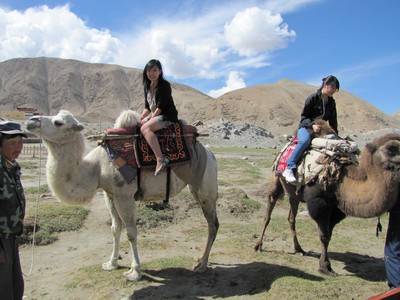
Lucy accompanied by a Kirghiz horse minder (what are his motives?).
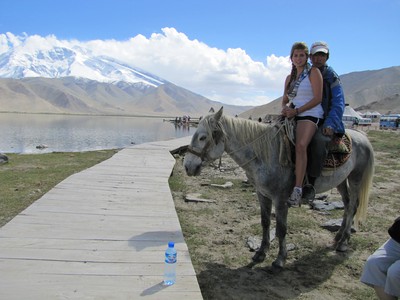
Liz on a horse.
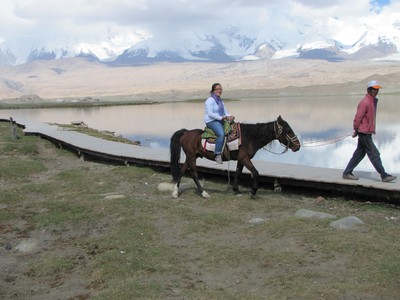
Adam and his horse.
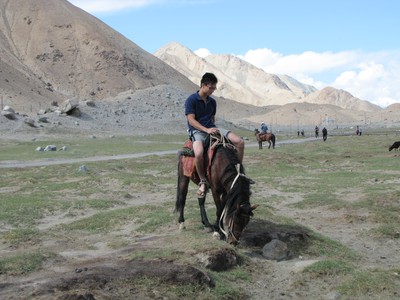
Joanna has ridden camels before and managed hers admirably on her own.

And so did Cynthia.

Miles looks like he wants to conquer Muztagh Ata next.

And finally, Muztagh Ata in all her glory. She is attended by a series of lower peaks. All photographed from a place that is about a mile higher above sea level than the tallest point in Sweden.
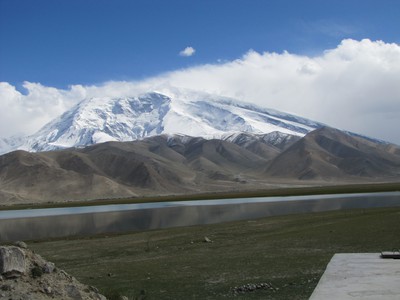
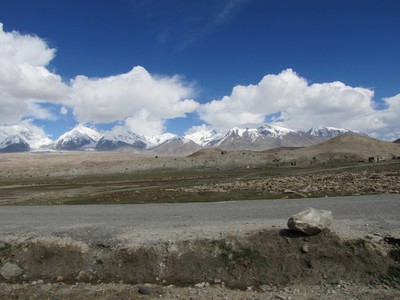
And as a PS, the old outhouse. Here one really needs to know something about non-European scripts to know which side one should choose. I dedicate this picture to the memory of my junior high school Swedish teacher, the brilliant Nils G Hörnström, who once said that one of his favorite visual jokes was an old cartoon of a man in obvious need staring confusedly at two doors with only texts in incomprehensible languages. He used this as an argument for learning foreign languages. In the thirty years since I heard this from him, I had never seen any such doors, until I got to Lake Karakul. (Hint: men go to the left.)

Something that makes the lake particularly beautiful is the mountain Muztagh Ata (7546 meters above sea level) that is often reflected by the surface of the lake. Sven Hedin tried to climb this mountain in 1894, but he failed.
A small group of Kirghiz people tried to sell handicraft and offered rides on camels and horses.
I liked the description of the lake on German Wikipedia: "berühmt für seine surreale Szenerie, welche sich mit großer Klarheit im Seewasser spiegelt, das von Dunkelgrün bis Azur- und Hellblau die verschiedensten Färbungen annimmt."
(As always in minority areas of China, it is hard to know how to spell names. I believe Karakul is Kirghiz, which is appropriate, for the population in the immediate neighborhood is Kirghiz. In Uighur, it is something like Karakolum, while it is different in Chinese: 喀拉库勒湖 Kalakule hu. Of course "Lake" is, strictly speaking, unnecessary, like "hu" in Chinese, since "kul" in Kirghiz means "lake". "Kara" means "black").
I am riding camel towards Mustagh Ata


Nichole and Cynthia riding.

Lucy accompanied by a Kirghiz horse minder (what are his motives?).

Liz on a horse.

Adam and his horse.

Joanna has ridden camels before and managed hers admirably on her own.

And so did Cynthia.

Miles looks like he wants to conquer Muztagh Ata next.

And finally, Muztagh Ata in all her glory. She is attended by a series of lower peaks. All photographed from a place that is about a mile higher above sea level than the tallest point in Sweden.


And as a PS, the old outhouse. Here one really needs to know something about non-European scripts to know which side one should choose. I dedicate this picture to the memory of my junior high school Swedish teacher, the brilliant Nils G Hörnström, who once said that one of his favorite visual jokes was an old cartoon of a man in obvious need staring confusedly at two doors with only texts in incomprehensible languages. He used this as an argument for learning foreign languages. In the thirty years since I heard this from him, I had never seen any such doors, until I got to Lake Karakul. (Hint: men go to the left.)

At home in Beijing
I came home to my apartment just before 2 a.m. It is nice to be back after a wonderful trip. Tuesday, I slept late and then went in to my office. I had a very good meeting with my second teaching assistant. Then we had a Master's Tea with Gu Xiaocheng, who is a retired professor at Peking University. She became a student at the university in 1948, when the Guomintang still held Beijing but lived earlier in Japanese-occupied Tianjin. So she has lived through some of the most interesting events in modern Chinese history: Japanese occupation, civil war, the Communist takeover, the Cultural Revolution, and the Opening of China to the West. She had many interesting stories to tell, and she told them in near-perfect English and with great charisma.
So here I am in my office just before the talk.
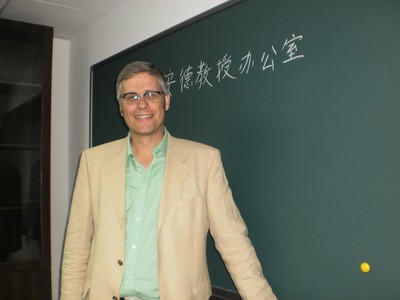
And here is the building in which our offices are.
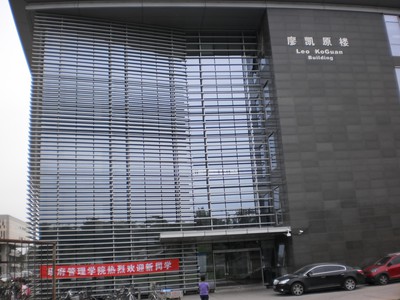
So here I am in my office just before the talk.

And here is the building in which our offices are.

Riding camel at Lake Karakolum
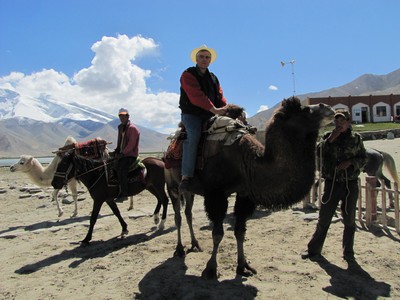
On our way to Beijing
The sand clouds have lightened, and the entire group has now checked in for a flight to Urumqi, from where we have a reservation today to Beijing. If everything works out fine, we should be able to get home today, although it might be past midnight. Ningping has done a wonderful job of rebooking us onto different flights.
Sandstorm in Kashgar
Today while we were at the livestock market of Kashgar, it seemed that fog was descending upon us. This turned out to be a dust cloud, very unusual this time of year in Kashgar. After a while, we all started to cough, since we breathed in the dust. Our very able guide Muhammed organized mouth protectors for all of us, which made it easier to breathe. We continued our program as planned, visiting the great mausoleum (which includes the mosque at which The Kiterunner was filmed), the Great Bazaar (where I haggled in uighur, which our guide had taught those of us who wanted on the very long bus ride the day before), the Great Mosque (where I for the first time in my life had the experience of removing my shoes to enter a mosque). Well, we had our usual day, fully loaded with exciting program points; we were just a little inconvenienced by all the dust. But of course, no airplanes can fly in sandstorms, so what we feared turned out to be reality: our evening flight to Urumqi was cancelled (we were supposed to stay overnight there and then continue tomorrow to Beijing). So our guide and Yale's administrators got on their cell phones and booked us for another night in the same charming hotel that we stayed at for the last two nights. Right now, Ningping is at the airline office to see if they think they can get us to Urumqi tomorrow morning instead so that we may continue to Beijing as originally planned. We'll see. We are not suffering meanwhile.
I made my way to a Chinese internet cafe. One hour of internet costs 2 RMB (2.20 SEK, 30 cents). The room is full of young people, most of whom are playing games (and smoking, as is done very much in this country). I was not supposed to be able to use the internet without showing my passport, but Ningping has that with her to the airline office. I showed them my Yale ID, and that seemed to work. Of course, I cannot upload any pictures here. I have really many pictures, which it will take me time to catch up with. We have had a wonderful trip, seen so many amazing sights. Yesterday, I rode a camel at the altitude of 3600 meters above sea level (which I suppose to equal about 10,000 feet) at the shores of a lake that reflected the snow-clad peak of X, some 7600 meters tall, in the Karakorum mountain range. (I will have to fill in the details when I can look them up.) I was wondering why I became short of breath without any real provocation, until I realized that it was the thin air at the altitude.
Stay tuned for more details and pictures when I am back in Beijing (whenever we get back; sandclouds do not necessarily settle very quickly, but they are optimistic that we might be able to fly out tomorrow morning).
I made my way to a Chinese internet cafe. One hour of internet costs 2 RMB (2.20 SEK, 30 cents). The room is full of young people, most of whom are playing games (and smoking, as is done very much in this country). I was not supposed to be able to use the internet without showing my passport, but Ningping has that with her to the airline office. I showed them my Yale ID, and that seemed to work. Of course, I cannot upload any pictures here. I have really many pictures, which it will take me time to catch up with. We have had a wonderful trip, seen so many amazing sights. Yesterday, I rode a camel at the altitude of 3600 meters above sea level (which I suppose to equal about 10,000 feet) at the shores of a lake that reflected the snow-clad peak of X, some 7600 meters tall, in the Karakorum mountain range. (I will have to fill in the details when I can look them up.) I was wondering why I became short of breath without any real provocation, until I realized that it was the thin air at the altitude.
Stay tuned for more details and pictures when I am back in Beijing (whenever we get back; sandclouds do not necessarily settle very quickly, but they are optimistic that we might be able to fly out tomorrow morning).
